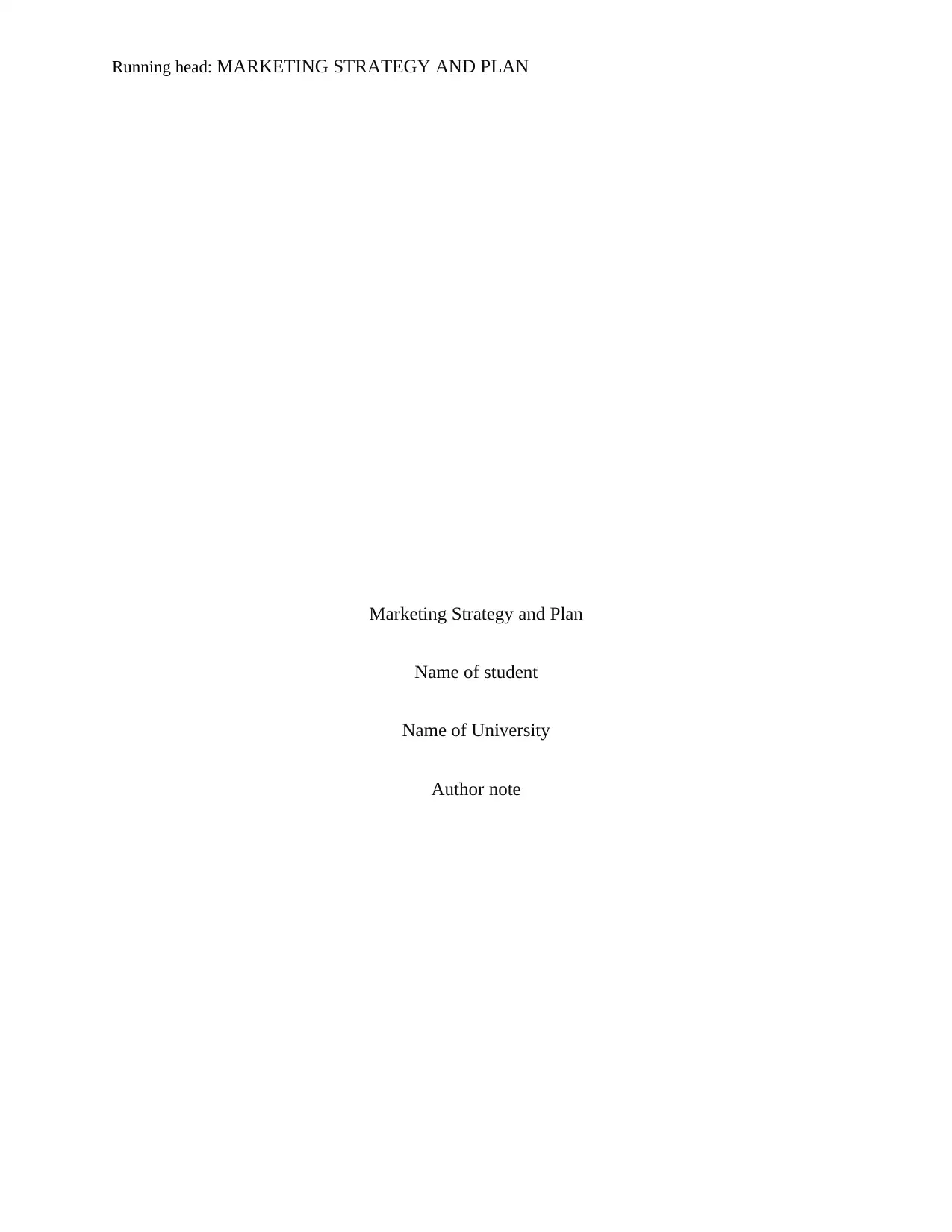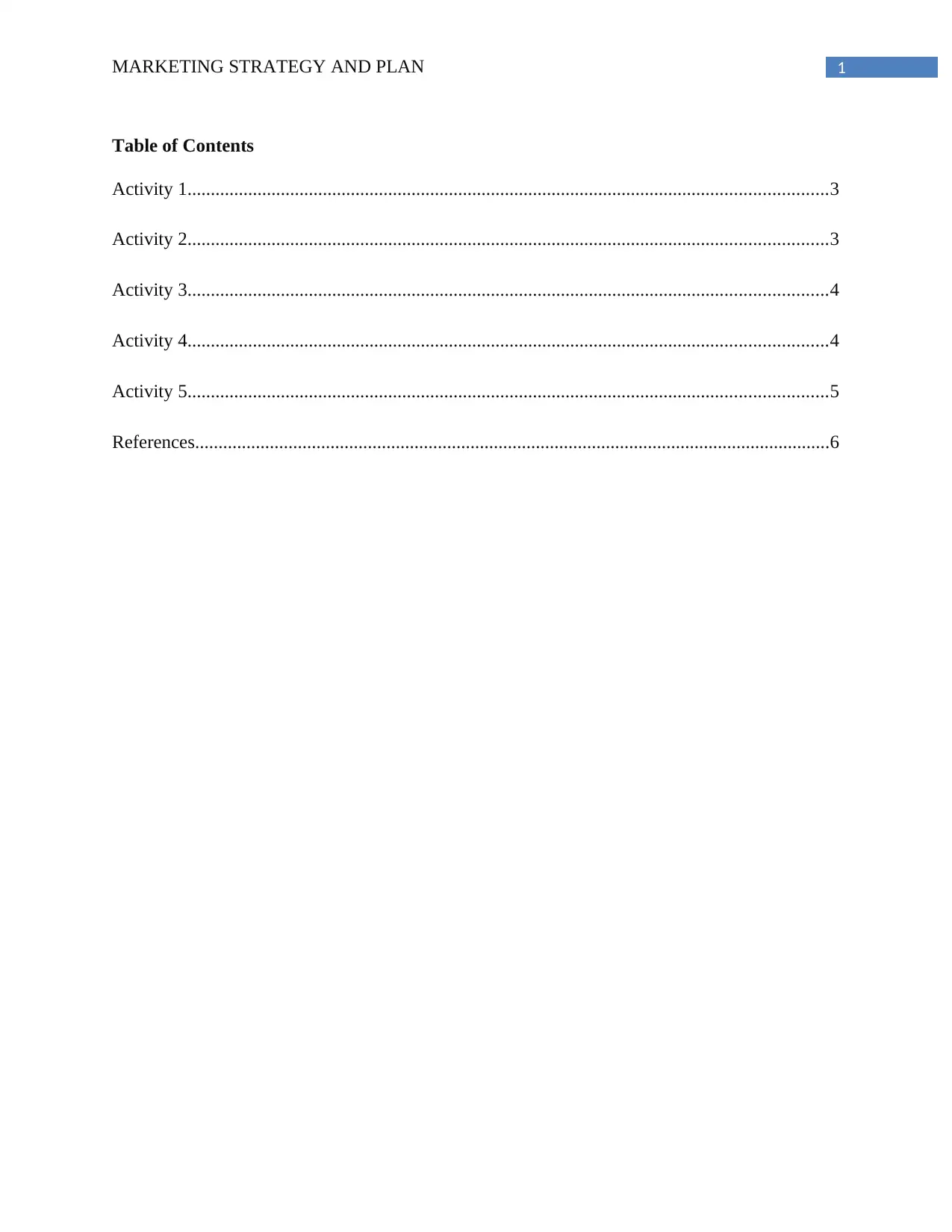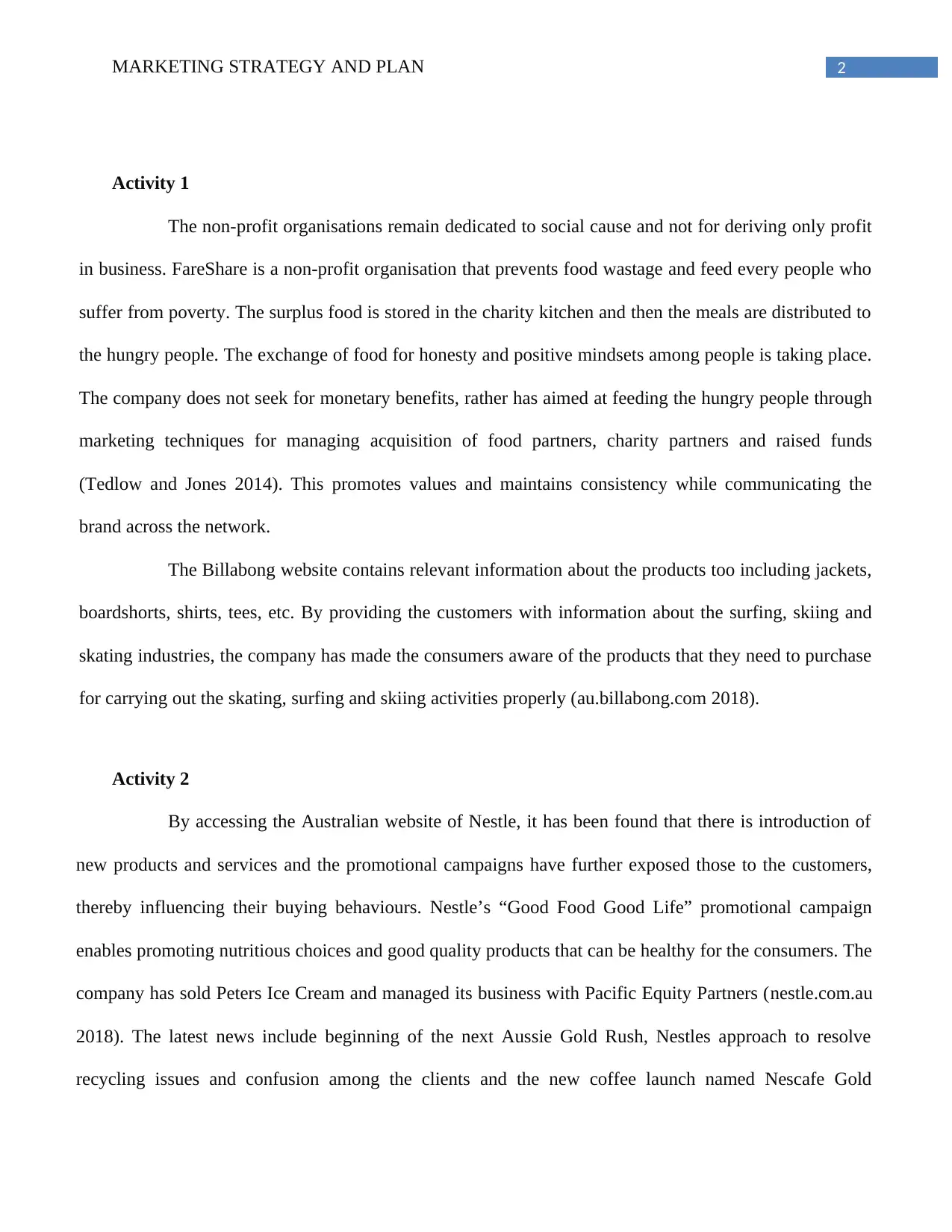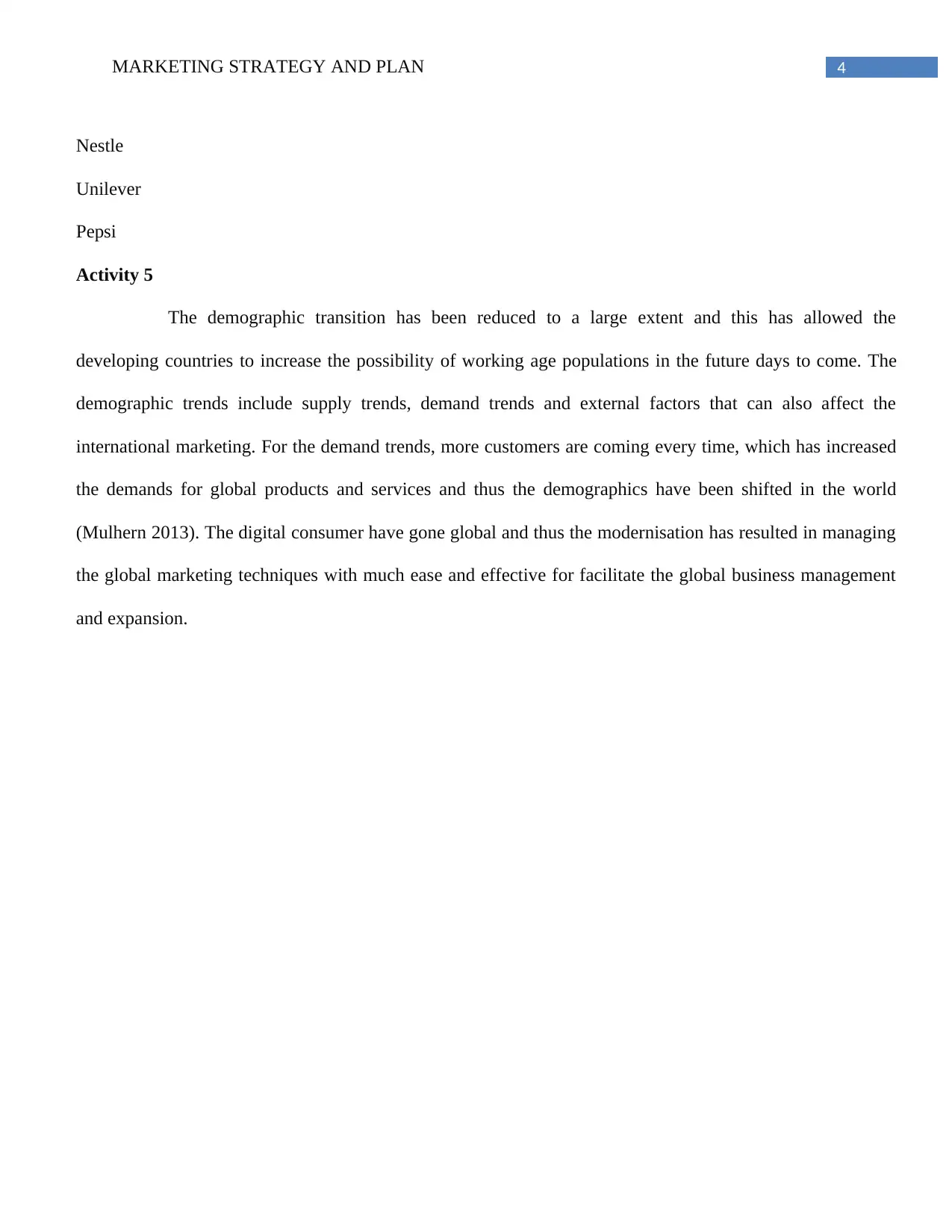Marketing Strategy and Plan: Nestle, Unilever & Pepsi
VerifiedAdded on 2023/06/08
|6
|949
|73
Report
AI Summary
This report provides a detailed analysis of marketing strategies and plans, examining the application of marketing concepts in both for-profit and non-profit organizations. It explores FareShare as an example of a non-profit implementing the marketing concept, focusing on its exchange model and profit objectives. The report also assesses Billabong's website strategy and its effectiveness in building customer relationships. Furthermore, it analyzes Nestle's marketing activities in Australia, including new product launches and promotional campaigns, identifying targeted market segments. Additionally, the report discusses income distribution strategies in the Northern Territory and examines market segmentation approaches used by Unilever, P&G, and Pepsi, ranking them based on market segmentation effectiveness. Finally, it addresses demographic trends and their impact on international marketing, highlighting the increasing demand for global products and services and the role of digital consumers in shaping global marketing techniques. This resource is available on Desklib, where students can find a wide array of solved assignments and study tools.

Running head: MARKETING STRATEGY AND PLAN
Marketing Strategy and Plan
Name of student
Name of University
Author note
Marketing Strategy and Plan
Name of student
Name of University
Author note
Paraphrase This Document
Need a fresh take? Get an instant paraphrase of this document with our AI Paraphraser

1MARKETING STRATEGY AND PLAN
Table of Contents
Activity 1.........................................................................................................................................3
Activity 2.........................................................................................................................................3
Activity 3.........................................................................................................................................4
Activity 4.........................................................................................................................................4
Activity 5.........................................................................................................................................5
References........................................................................................................................................6
Table of Contents
Activity 1.........................................................................................................................................3
Activity 2.........................................................................................................................................3
Activity 3.........................................................................................................................................4
Activity 4.........................................................................................................................................4
Activity 5.........................................................................................................................................5
References........................................................................................................................................6

2MARKETING STRATEGY AND PLAN
Activity 1
The non-profit organisations remain dedicated to social cause and not for deriving only profit
in business. FareShare is a non-profit organisation that prevents food wastage and feed every people who
suffer from poverty. The surplus food is stored in the charity kitchen and then the meals are distributed to
the hungry people. The exchange of food for honesty and positive mindsets among people is taking place.
The company does not seek for monetary benefits, rather has aimed at feeding the hungry people through
marketing techniques for managing acquisition of food partners, charity partners and raised funds
(Tedlow and Jones 2014). This promotes values and maintains consistency while communicating the
brand across the network.
The Billabong website contains relevant information about the products too including jackets,
boardshorts, shirts, tees, etc. By providing the customers with information about the surfing, skiing and
skating industries, the company has made the consumers aware of the products that they need to purchase
for carrying out the skating, surfing and skiing activities properly (au.billabong.com 2018).
Activity 2
By accessing the Australian website of Nestle, it has been found that there is introduction of
new products and services and the promotional campaigns have further exposed those to the customers,
thereby influencing their buying behaviours. Nestle’s “Good Food Good Life” promotional campaign
enables promoting nutritious choices and good quality products that can be healthy for the consumers. The
company has sold Peters Ice Cream and managed its business with Pacific Equity Partners (nestle.com.au
2018). The latest news include beginning of the next Aussie Gold Rush, Nestles approach to resolve
recycling issues and confusion among the clients and the new coffee launch named Nescafe Gold
Activity 1
The non-profit organisations remain dedicated to social cause and not for deriving only profit
in business. FareShare is a non-profit organisation that prevents food wastage and feed every people who
suffer from poverty. The surplus food is stored in the charity kitchen and then the meals are distributed to
the hungry people. The exchange of food for honesty and positive mindsets among people is taking place.
The company does not seek for monetary benefits, rather has aimed at feeding the hungry people through
marketing techniques for managing acquisition of food partners, charity partners and raised funds
(Tedlow and Jones 2014). This promotes values and maintains consistency while communicating the
brand across the network.
The Billabong website contains relevant information about the products too including jackets,
boardshorts, shirts, tees, etc. By providing the customers with information about the surfing, skiing and
skating industries, the company has made the consumers aware of the products that they need to purchase
for carrying out the skating, surfing and skiing activities properly (au.billabong.com 2018).
Activity 2
By accessing the Australian website of Nestle, it has been found that there is introduction of
new products and services and the promotional campaigns have further exposed those to the customers,
thereby influencing their buying behaviours. Nestle’s “Good Food Good Life” promotional campaign
enables promoting nutritious choices and good quality products that can be healthy for the consumers. The
company has sold Peters Ice Cream and managed its business with Pacific Equity Partners (nestle.com.au
2018). The latest news include beginning of the next Aussie Gold Rush, Nestles approach to resolve
recycling issues and confusion among the clients and the new coffee launch named Nescafe Gold
⊘ This is a preview!⊘
Do you want full access?
Subscribe today to unlock all pages.

Trusted by 1+ million students worldwide

3MARKETING STRATEGY AND PLAN
(Mulhern 2013). The demographic segments include products for the younger children and psychographic
include the customers who want the product readymade without wasting any time. Yes, this will be
successful, because it can draw in more clients and influence their buying behaviours.
Activity 3
In case a company wants to distribute its income in the Northern territory, then firstly, a good
socio-economic status should be maintained and measurement of wealth is essential. The data sources
including the occupation and qualifications could identify the economic scopes and opportunities;
furthermore produce a higher proportion of households with lower income though considering the large
capital wealth hold by the people who have retired. The management of income by done by allocating the
payment to pay for the major priority items including the necessity for food, housing, clothing, education
and medical care (Baker 2014). Their expenses are identified and necessary adjustments are made for
managing proper distribution of income.
Activity 4
Unilever has undertaken the market segmentation approach for obtaining information from
the websites and data regarding the product, price, place and promotions. The heterogeneous market is
divided into smaller segments considering the use of variables such as geographic, demographic,
psychographic and behavioural. P&G followed the digital marketing for delivering messages to people on
a mass scale and thus more people are influenced to make purchases for generating higher revenue and
gaining competitive advantage. Pepsi follows the mass marketing to differentiate the products through
targeting of market segments and increase its sales revenue (Tedlow and Jones 2014). The targeting
strategies have been beneficial and by understanding the needs of people in different market segments, the
segmentation would be perfect. Ranking based on market segmentation:
(Mulhern 2013). The demographic segments include products for the younger children and psychographic
include the customers who want the product readymade without wasting any time. Yes, this will be
successful, because it can draw in more clients and influence their buying behaviours.
Activity 3
In case a company wants to distribute its income in the Northern territory, then firstly, a good
socio-economic status should be maintained and measurement of wealth is essential. The data sources
including the occupation and qualifications could identify the economic scopes and opportunities;
furthermore produce a higher proportion of households with lower income though considering the large
capital wealth hold by the people who have retired. The management of income by done by allocating the
payment to pay for the major priority items including the necessity for food, housing, clothing, education
and medical care (Baker 2014). Their expenses are identified and necessary adjustments are made for
managing proper distribution of income.
Activity 4
Unilever has undertaken the market segmentation approach for obtaining information from
the websites and data regarding the product, price, place and promotions. The heterogeneous market is
divided into smaller segments considering the use of variables such as geographic, demographic,
psychographic and behavioural. P&G followed the digital marketing for delivering messages to people on
a mass scale and thus more people are influenced to make purchases for generating higher revenue and
gaining competitive advantage. Pepsi follows the mass marketing to differentiate the products through
targeting of market segments and increase its sales revenue (Tedlow and Jones 2014). The targeting
strategies have been beneficial and by understanding the needs of people in different market segments, the
segmentation would be perfect. Ranking based on market segmentation:
Paraphrase This Document
Need a fresh take? Get an instant paraphrase of this document with our AI Paraphraser

4MARKETING STRATEGY AND PLAN
Nestle
Unilever
Pepsi
Activity 5
The demographic transition has been reduced to a large extent and this has allowed the
developing countries to increase the possibility of working age populations in the future days to come. The
demographic trends include supply trends, demand trends and external factors that can also affect the
international marketing. For the demand trends, more customers are coming every time, which has increased
the demands for global products and services and thus the demographics have been shifted in the world
(Mulhern 2013). The digital consumer have gone global and thus the modernisation has resulted in managing
the global marketing techniques with much ease and effective for facilitate the global business management
and expansion.
Nestle
Unilever
Pepsi
Activity 5
The demographic transition has been reduced to a large extent and this has allowed the
developing countries to increase the possibility of working age populations in the future days to come. The
demographic trends include supply trends, demand trends and external factors that can also affect the
international marketing. For the demand trends, more customers are coming every time, which has increased
the demands for global products and services and thus the demographics have been shifted in the world
(Mulhern 2013). The digital consumer have gone global and thus the modernisation has resulted in managing
the global marketing techniques with much ease and effective for facilitate the global business management
and expansion.

5MARKETING STRATEGY AND PLAN
References
au.billabong.com. (2018). Billabong Mens Australia | Billabong. [online] Available at:
https://au.billabong.com/mens [Accessed 6 Sep. 2018].
Baker, M.J., 2014. Marketing strategy and management. Macmillan International Higher
Education.
Mulhern, F., 2013. Integrated marketing communications: From media channels to digital
connectivity. In The Evolution of Integrated Marketing Communications (pp. 19-36). Routledge.
nestle.com.au. (2018). Home. [online] Available at: https://www.nestle.com.au/ [Accessed 6 Sep.
2018].
Tedlow, R.S. and Jones, G.G. eds., 2014. The Rise and Fall of Mass Marketing (RLE Marketing).
Routledge.
References
au.billabong.com. (2018). Billabong Mens Australia | Billabong. [online] Available at:
https://au.billabong.com/mens [Accessed 6 Sep. 2018].
Baker, M.J., 2014. Marketing strategy and management. Macmillan International Higher
Education.
Mulhern, F., 2013. Integrated marketing communications: From media channels to digital
connectivity. In The Evolution of Integrated Marketing Communications (pp. 19-36). Routledge.
nestle.com.au. (2018). Home. [online] Available at: https://www.nestle.com.au/ [Accessed 6 Sep.
2018].
Tedlow, R.S. and Jones, G.G. eds., 2014. The Rise and Fall of Mass Marketing (RLE Marketing).
Routledge.
⊘ This is a preview!⊘
Do you want full access?
Subscribe today to unlock all pages.

Trusted by 1+ million students worldwide
1 out of 6
Related Documents
Your All-in-One AI-Powered Toolkit for Academic Success.
+13062052269
info@desklib.com
Available 24*7 on WhatsApp / Email
![[object Object]](/_next/static/media/star-bottom.7253800d.svg)
Unlock your academic potential
Copyright © 2020–2025 A2Z Services. All Rights Reserved. Developed and managed by ZUCOL.





